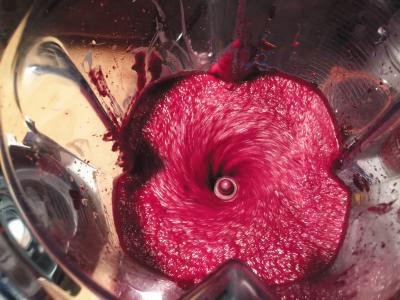Seasons by the Sea: Whip It Good: In Praise of Vegetable Puree

When is the last time you had a vegetable puree? Have you ever made one? And how long has it been since you saw one on a menu? I’m not talking about mashed potatoes; I’m talking about carrots, celery root, beets, and cauliflower.
After mama’s milk and formula, we all begin our lives with pureed foods. When we are on the back nine of life, we may end our lives with pureed foods. That is not what I am talking about! I am talking about velvety, sophisticated, rich, and elegant purees, smooth and full of flavor and color, created to match their accompanying dishes. For instance, a cauliflower, apple, and curry puree paired with a crispy-skinned magret duck breast; beets with jalapenos and mint to go with roast pork tenderloin, or a potato puree with fruity olive oil and chopped black olives alongside a piece of fried fish.
Vegetable purees are the alpaca blanket, the cashmere sweater, of winter foods. They are comforting, classy, and elegant. The French have always adored them, and Southerners seem to like them, too, maybe because most vegetables cooked Southern-style are so overcooked they’re one step away from a puree anyway.
The late, great lifestyle guru and cookbook author Lee Bailey devoted an entire chapter to vegetable purees in his “Good Parties” cookbook, published in 1986. The 1980s were a time when vegetable purees were popular, and also the, ’70s, when nouvelle cuisine was all the rage. This was an era when French chefs such as Roger Vergé, Paul Bocuse, and Jean and Pierre Troisgros began to lighten the traditionally heavy cream, butter, and flour-laden sauces and dishes, and to concentrate and simplify flavors.
A lot of chefs make vegetable purees to use as building blocks for other dishes, or to be the colorful swoosh on the plate under your protein. David Bouley, the New York chef, makes a red wine shallot puree that becomes the secret ingredient in many of his dishes.
One of the reasons I love making vegetable purees is that they can be made way ahead of time for a dinner party and they really are foolproof. They can also be as virtuous or as rich as you wish. Another reason I love making them is to surprise friends who thought they didn’t like them. Every time I serve Daniel Boulud’s cauliflower puree, or Amanda Hesser’s “Mr. Latte’s” pea and watercress puree, people ask for the recipes. I have shared the Boulud recipe here before, so I will give an abbreviated version this time. The Amanda Hesser/Mr. Latte recipe is from an old column she wrote about the first time he cooked for her. It is a menu so safe, so WASPy, so a-cross-between-nursery-and-country-club fare that I serve it often to guests who may not be foodies or may have food issues. Yes, it involves boneless, skinned white-meat chicken and mayonnaise, and no crunch, garlic, or onions. And the guests always rave about the pea-watercress puree.
If you think you are not a puree fan, think again. I’ll bet you like hummus, pesto, refried beans, guacamole, and cream of tomato soup with a grilled cheese sandwich, right? So you should give vegetable purees a chance. (Next I will convert you to aspics, another old-school, almost-obsolete creation that can be wonderful.)
A puree can focus on flavor of one vegetable, like carrots, or enhance and layer them, like celery root with potatoes, pear with kohlrabi, or leeks with butternut squash. Also keep the color wheel in mind. Carrots and broccoli may be tasty side by side, but puree them together and you’ll get an Army green-khaki kaka that will not convert your friends and family to vegetable purees!
As far as cooking methods, I like to steam whenever possible, rather than boil. This goes for carrots, green beans, and cauliflower. You could also roast and peel such vegetables as onions, beets, garlic, and shallots. For pureeing, you can use a blender, food processor, immersion blender, or Vitamix. (Just remember that potatoes should be mashed, not pureed, as this will make them gluey.) Don’t be shy with the salt and pepper.
Lastly, how rich do you want your puree to be? I do add a few tablespoons of butter to a pea puree and cream to a cauliflower puree but a little bit goes a long way. Potatoes and cooked rice can also serve as thickeners. You can extend the puree into a soup by thinning it with an appropriate stock, milk, or cream.
My diet is mostly whole grains and vegetables, not a lot of meat. So maybe that’s why I justify making my constant repertoire of vegetables occasionally a little bit naughty, and by that I mean lots of gruyere cheese on a zucchini, tomato, onion tian, or a big bunch of leeks baked with heavy cream.
Salads are varied, crunchy, and omnipresent at my table, green beans are either al dente or Szechuan-style. Eggplant gets miso. Brussels sprouts get pancetta, garlic, and pecorino. Shredded raw carrots get cumin and lemon juice. In other words, I lean towards aggressively savory additions, international flavors, and variety. But sometimes Yotam Ottolenghi, David Chang, and the allium family don’t belong at the dinner table and Audrey Hepburn does.
Try your hand at some sophisticated yet simple purees. You will be delightfully surprised. And I was kidding about the aspics. . . .
CLICK HERE FOR RECIPE
